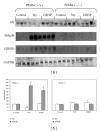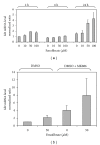Peroxisome proliferator-activated receptorα agonists differentially regulate inhibitor of DNA binding expression in rodents and human cells
- PMID: 22701468
- PMCID: PMC3373159
- DOI: 10.1155/2012/483536
Peroxisome proliferator-activated receptorα agonists differentially regulate inhibitor of DNA binding expression in rodents and human cells
Abstract
Inhibitor of DNA binding (Id2) is a helix-loop-helix (HLH) transcription factor that participates in cell differentiation and proliferation. Id2 has been linked to the development of cardiovascular diseases since thiazolidinediones, antidiabetic agents and peroxisome proliferator-activated receptor (PPAR) gamma agonists, have been reported to diminish Id2 expression in human cells. We hypothesized that PPARα activators may also alter Id2 expression. Fenofibrate diminished hepatic Id2 expression in both late pregnant and unmated rats. In 24 hour fasted rats, Id2 expression was decreased under conditions known to activate PPARα. In order to determine whether the fibrate effects were mediated by PPARα, wild-type mice and PPARα-null mice were treated with Wy-14,643 (WY). WY reduced Id2 expression in wild-type mice without an effect in PPARα-null mice. In contrast, fenofibrate induced Id2 expression after 24 hours of treatment in human hepatocarcinoma cells (HepG2). MK-886, a PPARα antagonist, did not block fenofibrate-induced activation of Id2 expression, suggesting a PPARα-independent effect was involved. These findings confirm that Id2 is a gene responsive to PPARα agonists. Like other genes (apolipoprotein A-I, apolipoprotein A-V), the opposite directional transcriptional effect in rodents and a human cell line further emphasizes that PPARα agonists have different effects in rodents and humans.
Figures



Similar articles
-
Peroxisome proliferator-activated receptor alpha (PPARalpha) agonists down-regulate alpha2-macroglobulin expression by a PPARalpha-dependent mechanism.Biochimie. 2009 Aug;91(8):1029-35. doi: 10.1016/j.biochi.2009.05.007. Epub 2009 Jun 2. Biochimie. 2009. PMID: 19497347
-
Differential gene expression in mouse primary hepatocytes exposed to the peroxisome proliferator-activated receptor alpha agonists.BMC Bioinformatics. 2006 Sep 6;7 Suppl 2(Suppl 2):S18. doi: 10.1186/1471-2105-7-S2-S18. BMC Bioinformatics. 2006. PMID: 17118139 Free PMC article.
-
Fibrates suppress fibrinogen gene expression in rodents via activation of the peroxisome proliferator-activated receptor-alpha.Blood. 1999 May 1;93(9):2991-8. Blood. 1999. PMID: 10216095
-
Identification of novel peroxisome proliferator-activated receptor alpha (PPARalpha) target genes in mouse liver using cDNA microarray analysis.Gene Expr. 2001;9(6):291-304. doi: 10.3727/000000001783992533. Gene Expr. 2001. PMID: 11764000 Free PMC article.
-
The role of peroxisome proliferator-activated receptor alpha in transcriptional regulation of novel organic cation transporters.Eur J Pharmacol. 2010 Feb 25;628(1-3):1-5. doi: 10.1016/j.ejphar.2009.11.042. Epub 2009 Nov 24. Eur J Pharmacol. 2010. PMID: 19941851 Review.
Cited by
-
Bilirubin Binding to PPARα Inhibits Lipid Accumulation.PLoS One. 2016 Apr 12;11(4):e0153427. doi: 10.1371/journal.pone.0153427. eCollection 2016. PLoS One. 2016. PMID: 27071062 Free PMC article.
-
Bilirubin, a Cardiometabolic Signaling Molecule.Hypertension. 2018 Oct;72(4):788-795. doi: 10.1161/HYPERTENSIONAHA.118.11130. Hypertension. 2018. PMID: 30354722 Free PMC article. Review. No abstract available.
-
New insights into apolipoprotein A5 in controlling lipoprotein metabolism in obesity and the metabolic syndrome patients.Lipids Health Dis. 2018 Jul 27;17(1):174. doi: 10.1186/s12944-018-0833-2. Lipids Health Dis. 2018. PMID: 30053818 Free PMC article. Review.
-
Impaired Thermogenesis and a Molecular Signature for Brown Adipose Tissue in Id2 Null Mice.J Diabetes Res. 2016;2016:6785948. doi: 10.1155/2016/6785948. Epub 2016 Apr 10. J Diabetes Res. 2016. PMID: 27144179 Free PMC article.
-
Bilirubin remodels murine white adipose tissue by reshaping mitochondrial activity and the coregulator profile of peroxisome proliferator-activated receptor α.J Biol Chem. 2020 Jul 17;295(29):9804-9822. doi: 10.1074/jbc.RA120.013700. Epub 2020 May 13. J Biol Chem. 2020. PMID: 32404366 Free PMC article.
References
-
- Watts GF, Dimmitt SB. Fibrates, dyslipoproteinaemia and cardiovascular disease. Current Opinion in Lipidology. 1999;10(6):561–574. - PubMed
-
- Panadero MI, González MC, Herrera E, Bocos C. Factors modulating fibrates response: therapeutic implications and alternative strategies. Endocrine, Metabolic and Immune Disorders. 2009;9(3):219–236. - PubMed
-
- Lefebvre AM, Peinado-Onsurbe J, Leitersdorf I, et al. Regulation of lipoprotein metabolism by thiazolidinediones occurs through a distinct but complementary mechanism relative to fibrates. Arteriosclerosis, Thrombosis, and Vascular Biology. 1997;17(9):1756–1764. - PubMed
-
- Corton JC, Bocos C, Moreno ES, et al. Rat 17β-hydroxysteroid dehydrogenase type IV is a novel peroxisome proliferator-inducible gene. Molecular Pharmacology. 1996;50(5):1157–1166. - PubMed
-
- Corton JC, Fan L-Q, Brown S, et al. Down-regulation of cytochrome P450 2C family members and positive acute- phase response gene expression by peroxisome proliferator chemicals. Molecular Pharmacology. 1998;54(3):463–473. - PubMed
LinkOut - more resources
Full Text Sources

